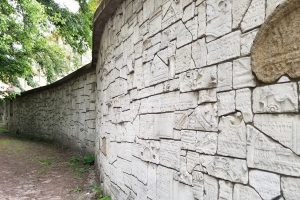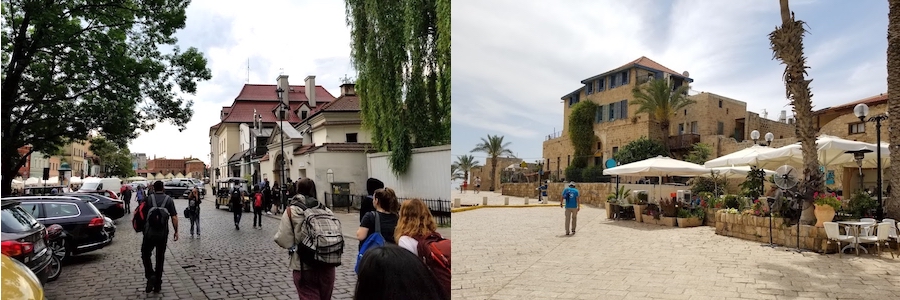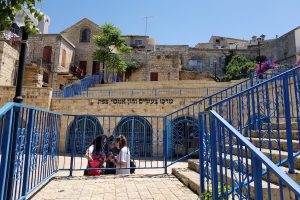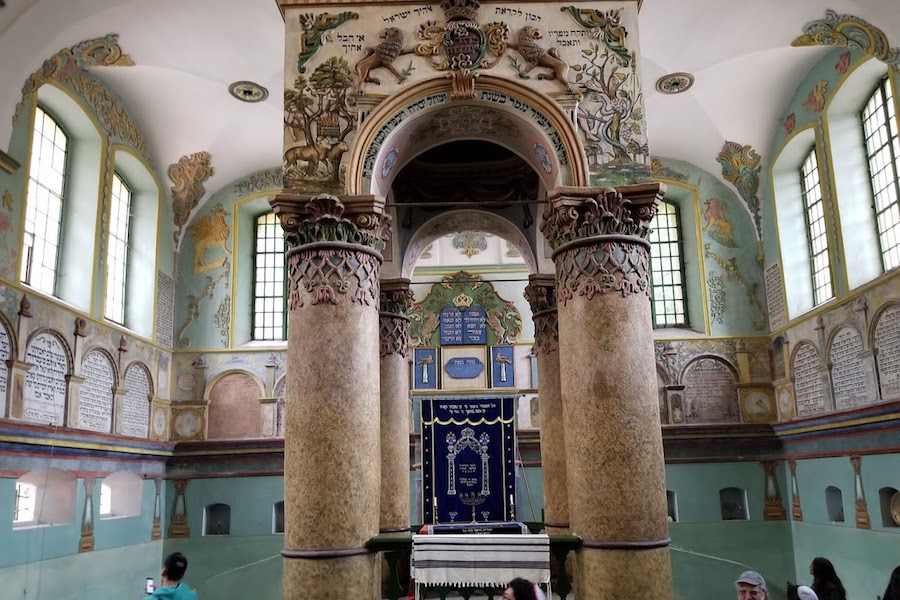On writers’ wings, a journey heavy with history
June 13, 2018
As someone who connects to things through writing — whether my own or someone else’s — I wanted to experience the senior Poland-Israel Experience through the written word. So I borrowed some books from a rabbi of mine that would relate thematically to the week in Poland and one-and-a-half weeks in Israel that would end my senior year.

The first book I read was The Story of a Life, by Aharon Applefeld, a famous Israeli author. In this memoir, he writes about his experience growing up in Germany, blissfully split between his Yiddish-speaking grandparents who lived in the forest and his secular parents who lived in a bourgeois, metropolitan apartment. Applefeld describes the rise of Hitler through the eyes of a seven-year-old, and life alone in the forest as a child orphan, learning to live off the land in the Polish countryside.
After the war, just old enough to be a bar mitzvah, he moves from refugee camp to refugee camp until he finally finds himself in Israel. Weak, starved, scared, alone, he is thrust into a life of physical labor, kibbutzim and mandatory army service.
I decided to read this book as we traveled, to feel the true Poland-to-Israel experience that really was. The one where millions of Jews’ lives were uprooted as they left their homes and businesses behind, put their children away into hiding, lost family members, saw and experienced the sadistic horrors of work camps — and then after years of torture and not knowing, jumped on a ship to Israel, a war-torn country with guns and worse pointed at it from every direction.
On my second day in Poland, as I rode past picturesque forests and lakes and looked with wonder at the infinity of slender trees outside my window, I thought about all the horror those tree trunks had seen — the teeth-chattering and starved-to-the-bone bodies. At the same time, that cobweb of greenery spanning Warsaw to Krakow also saved much life — including Applefeld’s. Much of what he wrote about sounded familiar to me: the baskets of food his grandmother always gave his mom to take home after a visit, the solitude of his grandfather, the wonder of a young child having first encountering the mystery of religious worship.
And then five days later, as I sat on the plane to Israel — for my first time ever — I read about Applefeld’s hatred for the Hebrew language that he was suddenly forced to speak. “My mother and her language were one and the same,” Appelfeld wrote. “Now, as that language faded within me, it was as if my mother were dying a second time.”
I myself was still reeling from the sense of loss that I felt visiting empty shuls and yeshivot in Poland. Krakow is the most beautiful city I have ever seen, and even now back in Los Angeles, I still wish it could be made once again breathtaking by Klezmer music, Yiddish, and Jewish religious practice that once filled its brick homes and fresh air. So on the plane to Israel — which at this point, represented to me the final blow to the world of Eastern European Jewry — I a loathing similar to Appelfeld’s: “From the moment I arrived in Israel, I hated the people who forced me to speak Hebrew, and with the death of my mother tongue, my hostility toward them only increased.”
And then, Jerusalem. Everywhere I walked in Jerusalem I saw the Holocaust. High-cheek-boned women with light eyes and headscarves looked like the unsuspecting Hungarian Jews in line at Auschwitz, waiting for a selection they could not have known would make a difference of life or death. Men in shtreimels and peyot looked like the yeshiva brains of Poland, Lithuania, Hungary and Galicia I had given a Los Angeles-prepared presentation on at Yeshivat Chochmei Lublin. In their thick black cloaks and hefty black hats, these men looked bizarrely out of place in Jerusalem’s desert heat. They looked like they were in exile in their own country. They seemed like they belonged in a more agreeable climate — like Poland’s, like Russia’s, like anywhere in the Eastern Europe that had thrust them out.
Seeing them was just a painful reminder for me as to why they are not there, and why they were here, against their own will.
Nowadays, we act like Israel was a choice — as though Herzl and so many others had awoken something that was mistakenly dormant for 2,000 years. In many ways they did — but in other ways they were reacting involuntarily to the lethality of anti-semitism. The largest migration of Jews to Israel came directly because of the Holocaust. And it was only three years after that cruel blessing-in-disguise genocide that we were able to get our Jewish state.
The fact that Israel was not a choice but a life raft presented itself to me mercilessly, endlessly, unsuspectingly. I felt it when I walked around Tzfat or other residential parts of Israel. The apartments all look the same — ugly — and seem like they were built too quickly. One can tell Jews were just trying to slap together four walls and a ceiling, over and over again, just saying “yallah,” just to get another body into another home, just to get rooms and bathrooms together to fit in more refugees, more bodies, more soldiers, more people. More life.
Back in Krakow, by contrast, the buildings and shuls had been awe-inspiring. Walls had Hebrew writing on them and paintings which bore carefully curated spiritual significance. Even the corners of buildings seemed to have had thought put into them. The Judaism in Poland had fermented slowly, over 700 years. Like a dish slow-cooked with thoughtful sprinklings of choice spices, Judaism there had time to infuse beauty, meaning and architecture into every aspect of its existence.
The Judaism in Israel came out of a microwave set on high for 30 seconds, trying to heat up a refrigerated meal at the end of a long day. It was fast, desperate, reckless, do-or-die, frantic.
The edifices of Jewish Krakow were made of stained glass, marble, granite, smoothed and painted stone. If the cantor’s hymns did not remind you of God’s existence, glorious frescos above your head would. But the buildings in Israel were often made of sandstone; in Israel, there was no time for paintings or delicacy or stained glass or marble. There was just build, build, build — fast, fast, fast. We have another boat of refugees from Italy coming in today! Yallah! You can hear the architects of sprawling buildings yell. They grabbed the only thing they had — the sand on their shores — and built, built, built. Sandstone.
That Israel is a product of Jewish trauma was thus felt at every moment, and made even more intense for me by the reminiscences of Applefeld. As I looked at the men in Mea Shearim in their heavy black jackets, my Israeli chaperone told me there is actually a fainting problem in the summer due to the layers of polyester worn for modesty by Orthodox Jews in the city’s triple-digit summer hear. This was another reminder to me of the history of Jews. Ashkenazi Jews and their heavy garb come from the snow-laden lands of Europe; shtreimels come from the dress of Russian nobility (though some say Jews were made to wear fur hats to make them identifiable).

The fact that such traditional wear is born of a faraway climate and not Israel — not here, not our original place — reminds us again of the original exile. Had we stayed in Israel, Haredim would not wear such suffocating clothing. Most of what is seen as “Israeli culture” is not Israeli — it’s an amalgamation of our past. We call things “Israeli,” but the term means nothing, few things are actually Israeli because the state was not able to exist for centuries. Israel as a place with a real national cultural is relatively new — there are people older than the state of Israel. Cucumber-and-tomato “Israeli salad” is actually an Arab dish in origin, Halvah is not exclusive to Israel, Naot are basically Birkenstocks, Blundstones are actually Australian, and so many other classical features of Israel are inherited from our Diaspora.
I visited a friend on Ben Yehuda Street for dinner, and as he is making aliyah, he has a lot of Israeli friends. He told me repeatedly, despite having lived in the country for only one year, that “this is a country of trauma.” We davened Kabbalat Shabbat in the Old City. Our religious security guard sat back, relaxed with his peyot danging behind his ear, his tzitzit swaying with the same rhythm. But also hanging with the same nonchalance was a gun from his belt loop. It was an unusual sight for me as an American Jew, who experiences Orthodox Jews as nonviolent and physically weak. But that is how I will forever see Israel — the image is a religious man or woman, who anxiously carries a gun at all times on the off-chance a moment will come to drop everything and shoot.
My friend and I went to a public restroom in Tzfat, where there was a man whose job it was to collect two shekels from those who wished to use the bathroom. He was really old, so old it seemed that this job of sitting all day and collecting money from tourists was even too much for him. On my way out I wanted to ask him where he was from, because his broken skin and glass eye made me realize he could not have been born here. Before I could, though, as if he had a sixth sense, he started shouting eerily: “From Belorussia! Belorussia! Belorussian.” I smiled and told him my grandfather was from Poland and walked away, which is the biggest regret I brought back from my time in Israel.
Nevertheless, it felt as though he was trying to preserve something that is coming to an end. He knows he is an old man and that the generation of Jews who came from Europe, North Africa, the Middle East — everywhere — whose experience of the 20th century’s terrifying persecution and murder of Jews is evaporating. He was yelling his heritage to my friend and me as we walked back out onto the street, like he was trying to remind us where we all really came from. We think these jewelry stores and art boutiques and paved roads are all just natural, that God just put this here the way He put the Garden of Eden someplace a few miles away. But people like that bathroom attendant built this place, they watched Israel grow. He was here first.
The experience in Poland, mixed with the truth I felt only I knew by living my travels alongside an author-survivor like Appleman, left me utterly disengaged from Israel. My whole life I listened to friends and acquaintances describe a “sense of belonging” they feel there. But I felt more warmth in Poland than in Israel. Guilt lingered over me as I tried to connect, often asking myself at various points, “Do you feel like you belong now?”

I felt momentarily connected to Israel during the all-nighter I pulled on Shavuot. Maybe it was the lack of sleep, or simply the view, but standing on a Jerusalem rooftop — overlooking the Old City — I couldn’t help but understand the beauty of Yerushalayim. As my whole class sang zmirot at dawn, I felt like I was singing to Jerusalem, a historic city which served as a scathing reminder of my own nothingness. The second book I read was A Tale of Love and Darkness, a memoir by Amos Oz, in which he describes Jerusalem: “The city has been destroyed, rebuilt, destroyed and rebuilt again. Jerusalem is an old nymphomaniac who squeezes lover after lover to death, before shrugging him off her with a yawn like a black widow who devours her mates while they are still penetrating her.”
A tour of the caves beneath Jerusalem two days later revealed both the literal and metaphorical layers of the city. Megillat Ruth is read on Shavuot, and reading the story reminded me of Israel’s purpose. Ruth and Naomi arrived in Israel because both were abruptly widowed, and thus poverty-stricken. This was the only land in which peasants like them could glean the barley fields. They were not Israeli women, they were newly arrived from Moab, but Israel welcomed them with open arms, just as it did seven decades ago, and as it continues to do.
I flipped past the last page of Ruth in my Tanach, and found Lamentations. I read several pages to myself as a silent prayer for Jerusalem. Perhaps presaging Oz’s point, Lamentations opens: “She weepeth sore in the night, and her tears are on her cheeks; she hath none to comfort her among all her lovers; all her friends have dealt treacherously with her, they are become her enemies.”
Lamentations tell the story of Jerusalem’s worst years. Times when the city was laid siege to, where mothers ate their infants fresh out of the womb, where trash and bodies piled up in the roads. The descriptions, “The hands of compassionate women have boiled their own children,” and the final line in which the writer cries, “Restore us to yourself, Lord, that we may return; renew our days as of old unless you have utterly rejected us and are angry with us beyond measure,” reminded me deeply of the Warsaw ghetto. The siege, the entrapment, the starvation; the poverty, disease; thousands cramped into an unforgiving space which was once vibrant and now reeks of death.
People believed God had given up, forgotten Zion, forgotten Jerusalem and the Jews. But Jerusalem was rebuilt. Overlooking the Old City, I forced myself to remember that. As much as I see Israel through the lens of Holocaust survival, and as a painful proof of that genocide, I am grateful to live during a point in Jewish history of rebirth.
Amos Oz, whose parents never let him visit the Europe they had fled, recently said in an interview with the German international broadcaster Deutsche Welle: “My parents never shared with me their disappointed love of Europe. But I could sense that pain and the longing. I could even guess that they were trying to artificially create a little enclave of Europe in the middle of the heat and arid atmosphere of Jerusalem.” If he had seen what I saw, he would have understood the truth about the Jewish transition from Europe to Israel.
Though I did not connect with Israel in the way my friends did, I connected deeply with the literature surrounding my experience. I learned from cobblestones and sandstone, Appelman and Oz.
The Jews have never come to Israel at a convenient time or arrived in comfort or in style. Whether it was after 40 years wandering the desert, fleeing some sort of persecution, or hoping for a better life, Israel is a small lifeboat for Jews in the prodigious ocean of an often forbidding world. So its stony streets reminded me of the cobblestone in Krakow, and the sandstone reminded me of the urgency of the State of Israel, and cloaked men evoked memories of grave sites, and I was just happy to see all of this at a time of such prosperity, born out of desolation.
